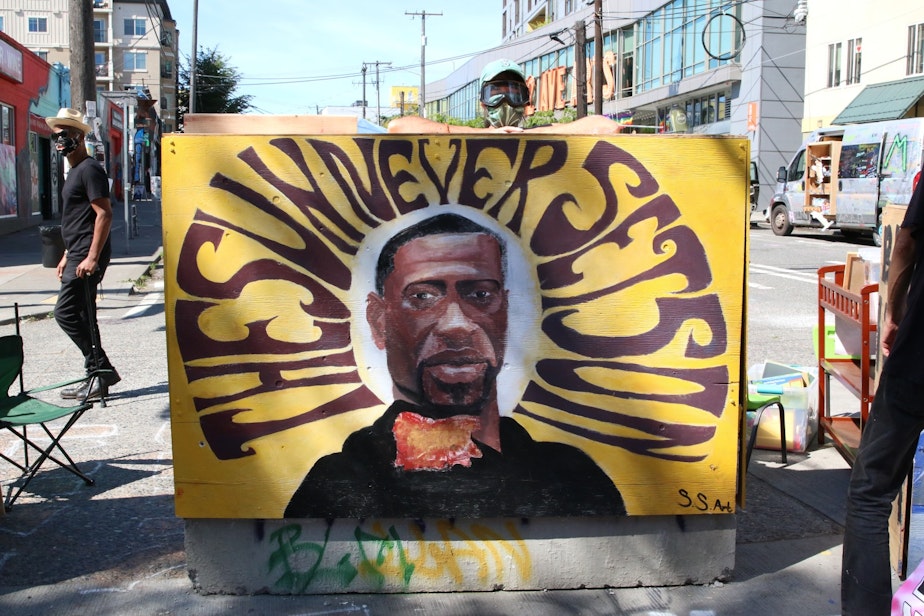CHOP will end, but the memory of its art will remain

Murals around the Capitol Hill Occupied Protest Zone in Seattle are disappearing. Most of the brightly-colored barriers were gone as of Tuesday. And the words painted on the street are already looking less bright.
Over the last few weeks, KUOW's been talking to people painting graffiti in the CHOP to learn what it meant to paint in the streets during a movement like this.
It’s hard to believe it was almost three weeks ago that artists were covering the CHOP with fresh paint.
"Basically, my buddy Joey saw the mural that happened in DC and other cities around the country and was like we need to do this here," recalled Ward, who invited artists to paint "Black Lives Matter" in huge letters on the street.
Perry Paints was invited to paint an "L."
"Within each letter, each artist is making their own special mural. So each letter will have its own kind of art within it, so it's an art piece within an art piece," he said at the time. "So I'll be painting a bunch of Black women, since I appreciate Black women, as the women in my life."
But now, the protective barricades are gone, and activists have asked the city to seal the street mural to protect it from cars.
Sponsored
Even if it disappears though, its influence will still be felt by the artists it inspired to come out and paint their own art.
Sponsored
In some places, their work resulted in damaged property - like when people painted the bathrooms at Cal Anderson Park. But much of the graffiti was done on temporary plywood boards that were either covering shop windows or attached to street barricades.
Those surfaces became a place for people to express themselves, often anonymously. An artist named Jacob painted a U.S. flag on one of the street barricades. The flag is made out of the letters BLM, for Black Lives Matter.
"I was not there when people were tolerating the tear gas. They’re real heroes. And I’m really proud of them. And I hope that those tears don’t get wasted," said Jacob.
Jacob said he wished he could have protested more. But he feared getting deported back to Iran. Graffiti was somethin he felt he could do.
"So I just went to Blick and got the spray paint. And coming out and just painting - it was amazing. It felt really good. It's going to be gone soon, but I hope the message doesn't go away: 'You cannot ignore Black people's life in this country. You cannot deny your people. They are citizens, they are American and they have rights, exactly the same rights that everyone else has.'"
Sponsored

That piece is gone now. So is the barricade mural created by an artist who goes by her initials, S.S.
"So I was talking to this little Black girl," the artist recalled. "She was 6 years old, and I was just telling her 'I’m painting the sunshine on George Floyd.' And so she was helping me with the sunshine for a bit. And then she took red and started adding it on the mural.
"And I said 'Why did you add the red?' And she said 'there needs to be blood on it.'"
Sponsored
"And... oh my God, that just broke my heart. So I decided to keep her contribution here at the neck," said the artist, pointing at a red smear of paint at the bottom of the mural. "That was her piece in this. Because she needed it more than I did, obviously."
"Kids have so much to say. You just give them the expression and they just go for it. There’s no block, there’s no 'I’m not an artist,' you know that a lot of adults have, there’s no 'Tell me what to paint,' they just go out and do it. It comes straight out of their heart.”
So what’s happening to all this art that’s disappearing from the CHOP?
Artists there have collected some of it. Some of it will probably end up in the garbage. Some of it is monumental in scale. There’s a two story high sculpture of a Black Power fist in Cal Anderson Park.
Sponsored
The City’s Office of Arts and Culture has promised to memorialize some parts of the CHOP.
A spokesperson for the Museum of History and Industry, which recently exhibited protest art from Seattle’s WTO demonstrations in 1999, said the most important thing is to prioritize the wishes and needs of the activists and artists who have been part of the movement in the CHOP.

